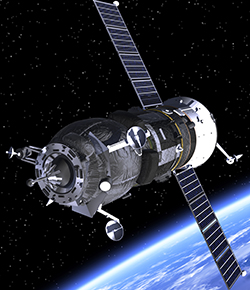From the Ground Up: The Role of Satellite
in a New Communications Landscape
By: Helen Weedon

The communications sector is undergoing an era of fundamental change, a change that is happening both way above our heads as well as down here on the ground.
On one hand, the telco industry is moving at full tilt towards 5G. This network of networks will see the interweaving of different access technologies that leverage automation, virtualization, and orchestration to meet the huge demand for connectivity with the right technology in the most cost-effective manner possible. Facilitated by cloud-based services, it will connect everyone and everything. Our homes will feature networked appliances. Our businesses and cities and transport networks will all be interconnected.
Simultaneously, there is a disruptive revolution going on within the satellite industry. Satellite capabilities have transformed. This began with the introduction of high throughput satellites that offer much higher throughput at lower cost. Satellites are powerful, software-defined, highly flexible, re-configurable, and able to switch seamlessly from one beam to another. Additionally, and most significantly, we are moving into the multi-orbit age, where many thousands of satellites are in the process of being launched into both low and medium Earth orbits, reducing latency and broadening out appeal to multiple applications both established and emerging.
So how are these two transformations related? Satellites have a critical role to play in the network of networks. Satellites are unique in their ability to bridge
existing connectivity gaps and reach remote locations. They know no geographical boundaries and therefore can enable ubiquitous connectivity where terrestrial technologies fall short. Satellites
will therefore be essential in the new world of 5G, and will need to be seamlessly integrated into this new connectivity fabric so that the right technology medium is always available for the
right application at the right time.
About Promptlink - www.promptlink.com
Promptlink Communications is an industry innovator in network noise detection and CPE testing, with 15 patents demonstrating the innovation and breakthrough technology Promptlink
has developed. One key innovation has led to solving the puzzle of localizing and repairing ingress and other types of HFC noise and impairments. Machine learning and a huge library
of labeled data is used to identify the type of noise or other impairment and sends the specific location directly to a technician, with no analysis required. Promptlink’s Network
NoiseHawkAI provides a fully-automated solution for localizing, diagnosing and repairing Upstream Noise and other impairments. NoiseHawkAI automatically localizes a point in your
network, provides instructions to find and fix the issue, and validates the fix. All steps are fully automated, using the latest AI technology to send all info straight to a
smartphone. Promptlink's patented and award-winning solution is one-of-a-kind. This is only one of many unique solutions provided by Promptlink.
Sounds ideal, doesn’t it? But getting there is an extremely complex process, and there are some key foundation stones that must be laid to ensure that satellites can take their place in the network of the future.
Preparing the ground
Ground infrastructure is integral to the transformation of the space segment. Without it, there is no transformation. So, it’s absolutely critical that it is right, and this takes industry collaboration involving the entire ecosystem.
The biggest challenge is how ground infrastructure providers can make such a complex task simple using smart resource management.
An LEO constellation requires numerous ground terminals at many locations around the world to manage a global satellite system. Each specific location needs a minimum of two terminals, but some major sites will require a minimum of three and as many as twenty. This presents the first great challenge: How does one go about managing such a high number of terminals?
The answer is by keeping things as simple as possible, using common ‘smart’ terminal packages with a configurable ‘black box’ interface. Each antenna system is then regarded as a fully independent and managed node and completely identical. This will mean that each site will be reliable and easy to set up, manage, test, and reconfigure.



















